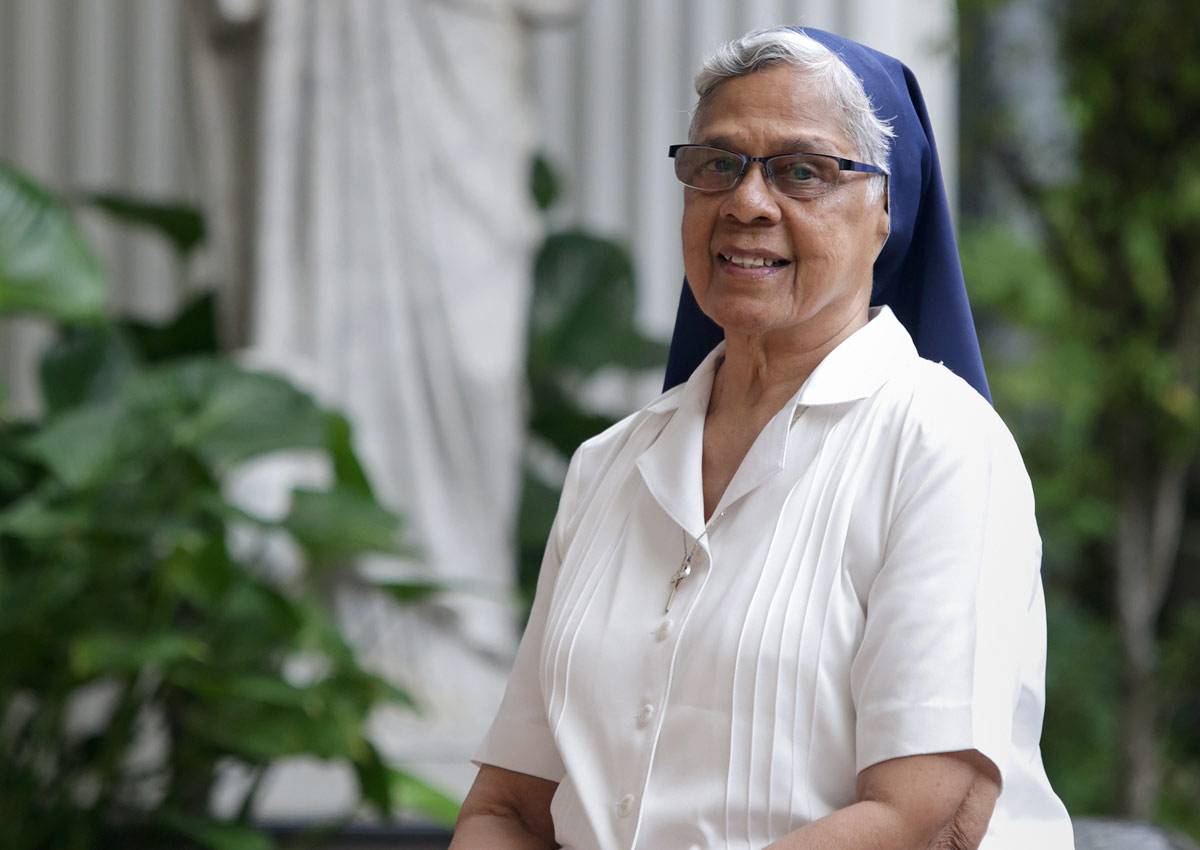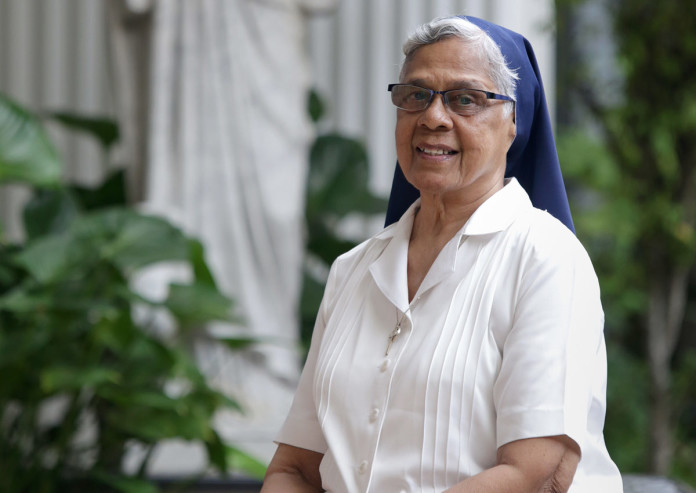Sister Gerard Fernandez is sitting in a meeting room at the Good Shepherd Place in Toa Payoh, telling stories about her past in a voice clear, calm and soothing.
It was the early 1940s and she was then barely six years old.
Her late father – who was secretary to the chief justice – spoke impeccable English, and would put his children through enunciation drills while waiting for breakfast.
One morning, they had to recite a verse which went: “And I commit you to Sing Sing Prison, there to be hanged, drawn and quartered.”
Sing Sing is a maximum security prison in New York City.
“I remember saying to myself ‘I don’t like those words and I’m not going to say them when my turn comes’,” says the nun, now 78.
Instead, she recited a prayer honouring the Virgin Mary when her turn came. “I went: ‘Hail Holy Queen, Mother of mercy, hail, our life, our sweetness and our hope’.”
Her father, who did not know she had committed the prayer to memory, was stunned, and delighted.
For Sister Gerard herself, the episode is perhaps prescient. She became a Changi Prison counsellor for those sentenced to hang.
Among them were Catherine Tan Mui Choo and Hoe Kah Hong, the women who helped medium Adrian Lim kill two children in the sensational ritual murders case of 1981; Flor Contemplacion who murdered a fellow Filipino domestic worker and her four-year-old charge in 1991, and Van Tuong Nguyen, the Australian drug trafficker sentenced in 2004.
“At the age of 36, I walked with my first inmate on death row. I wasn’t aware of the call then but I guess it was long implanted in my heart,” says Sister Gerard who joined the Good Shepherd Sisters, a Roman Catholic order of nuns, when she was 18.
Blessed with a serene demeanour and prone to bouts of girlish giggles, she is the fourth of 10 children.
“My parents were the most generous and loving of parents; my faith came from them,” she says, adding that two of her sisters are Franciscan nuns.
Her early years were happy ones, spent in a house in McNair Road. The chief justice visited the family every Christmas, and allowed them use of his Jaguar during this period.
“We also had a pet pig running around the house,” she recalls.
But the pig got slaughtered when her father uprooted the family to Malacca during the Japanese Occupation.
“My uncle came to do it. Mum salted the meat, put it in a jar and that was what we lived on during our journey to Malacca.”
After a couple of years in the Malaysian state where one of her younger sisters died of tetanus poisoning after being pricked by a thorn, the Fernandez family returned to Singapore and a new home in Cairnhill.
After completing her secondary education at Convent of the Holy Infant Jesus in Victoria Street, she taught briefly at the Good Shepherd Kindergarten in Kampung Java before becoming a nun.
She felt the call to serve, she says, after meeting the Good Shepherd sisters who ran Marymount Centre in Thomson.
The place, which had to make way for the North-South Expressway, had several outfits including a welfare home and shelter for women and troubled teens.
“At the shelter, I saw this teenage girl, and she had such sadness on her face. I told myself: ‘This is where I want to work, with girls like her’.”
When she broke the news to her father one morning while he was having breakfast, he did not choke on his coffee.
“He put down his newspapers and said: ‘Are you sure you want to do that?’ And when I said yes, he said: ‘The only thing I want you to know is that I am ready to see you through a tertiary education. Do you want to go now?’
“I said: ‘Yes, if I don’t, I may lose my vocation’,” she recalls with a laugh, adding: “I was actually a very happy teenager, I enjoyed my life, going to parties and all.”
Her late mother too, she says, readily gave her blessings.
On May 19, 1956, she entered the Good Shepherd Convent in Marymount; she was 18 years old.
After two years of formation – the process of learning about the religious life – she took her first vows.
Life in the convent was not easy.
“I came from a closely knit family and I missed them very much. There were times when I wanted badly to go home. On Christmas Day especially, I felt the loneliness and I remember I’d cry in the chapel,” she says.
“But it’s a matter of going deep down into your heart and asking what you really want.”
During her formation, Sister Gerard attended two years of teacher training and taught primary school pupils at Marymount Convent from 1959 to 1962.
Her first mission was in 1962, when she went to Jakarta for four years to work with troubled teenagers.
The work was fulfilling but sometimes harrowing because of the political turmoil which rocked Indonesia then.
She recalls the Lubang Buaya incident in 1965, when a group of Indonesian military personnel captured and murdered six generals.
It was the start of an abortive coup that eventually led to the ouster of Sukarno, Indonesia’s first president.
This period was also marked by large-scale killings targeting communists, ethnic Chinese and suspected leftists.
Even the Good Shepherd Convent in Jakarta where she was based, was a target.
“But we were protected by students. It was a frightening experience,” says Sister Gerard who went back to the country for another stint between 1972 and 1975.
Over the next few decades, she worked with the abused, the lost and the marginalised.
“My calling is people who are broken,” she says simply.
In the 1970s, when drug abuse was rampant in Singapore, Sister Gerard, already a counsellor, attended more counselling and rehabilitation courses held by the Singapore Anti-Narcotics Association and started working with drug addicts.
Not long after, she founded the Roman Catholic Prison Ministry with two Redemptorist priests, Father Brian Doro and Father Patrick John O’Neill, to visit drug offenders, as well as other prisoners.
“In the beginning, we would go all the way to the prison even if it was just to see one prisoner. But now, we see nearly 20 inmates every week. From just four counsellors, we now have more than 100 in the Roman Catholic Prison Ministry.”
Her work with prisoners took a dramatic turn in 1981 with the ritualistic murders of two children by self-styled medium Adrian Lim, his wife Catherine Tan and mistress Hoe Kah Hong.
The case was especially shocking for Sister Gerard because she knew one of the victims, nine-year-old Agnes Ng whose elder sister was a cook at Marymount, as well as Tan who attended the Marymount Vocational Centre.
“I knew Catherine’s father too, he was an electrician and used to do the Christmas lights at Marymount,” she says.
Tan, she says, was a sweet and simple girl who fell into bad company after she left Marymount. Lim made her go into prostitution and eventually led her to the gallows.
Sister Gerard felt a “desperate” need to see Tan, and wrote to her. Six months passed before the latter replied and agreed to see her.
“When I walked in, she looked at me with her sad eyes which said: ‘You haven’t condemned me. Please help me change’.”
For seven years, until the three of them were hanged in 1988, Sister Gerard made weekly visits to pray with Tan and steer her back to her Catholic faith.
Not long after, Hoe, who was in the next cell, also sought her counselling.
Over three decades, the nun has “walked” with 18 convicts to the gallows, sometimes spending long nights with them in prayer.
Not all of them, she says, were Catholics. “There was this guy Kumar, he committed murder. He said he had seen me pass by his cell and heard me sing.”
The day before he was to be hanged, he asked to see her.
“He said: ‘Tomorrow morning, I’m going to see God and when I do, I will tell him all about you’,” she recalls softly.
Candidly, the sister lets on that she opposes the death penalty because it takes away life which is precious. “But I won’t give up the opportunity to be there for these people. When I walk in there, I can see a spark of hope in their eyes. It doesn’t come from me, it’s from the divine,” she says.
Although she is claustrophobic, she has never felt fear walking through the oppressive cells and corridors of the prison.
“Many have asked me where I get the strength to do it. I have questioned myself too. That’s why I believe this is a calling. I do not look at it as something I’m doing; it’s a relationship between the inmate and myself.
“It is most beautiful when they say: ‘Yes, I have done wrong but I have hope’,” says Sister Gerard, who calls all those she has walked with her friends.
Australian drug trafficker Van Tuong Nguyen, 25, who was hanged in 2005, asked her to be by his side in his final moments.
But she did not.
“That would have been too traumatic for me,” she says.
Last year, she decided to pass the baton. “I just felt it was time to stop. I have a team of people ready to take over,” she says.
Just two years shy of her 80th birthday, she still leads an active life despite having 10 screws implanted in her back, and hip replacement surgery a few years ago.
Her days at Good Shepherd Place, where she still works with troubled teens, counsels couples and helps “broken souls”, are packed.
“Don’t make me out to be a saint,” she repeatedly tells me. “I have my dark moments. My ego can be as big as a satellite. But I try to use the dark moments to become better. I’m 78 and I know when to pull back because that’s not the way to live.”
Asked to describe herself, she giggles and says: “I enjoy people and love chocolates.”
She enjoys good relationships with many people, she says, because she is not afraid to love.
“My heart is full of love. Because I’ve made a vow of chastity, it frees me up to love everybody. You can’t hold back and if you do, something’s not right,” she adds with a grin.
Sister Gerard sets great store by the words of St Mary Euphrasia Pelletier who founded Sisters of The Good Shepherd. “One person is more precious than the whole world.”
kimhoh@sph.com.sg

This article was first published on December 25, 2016.
Get a copy of The Straits Times or go to straitstimes.com for more stories.







